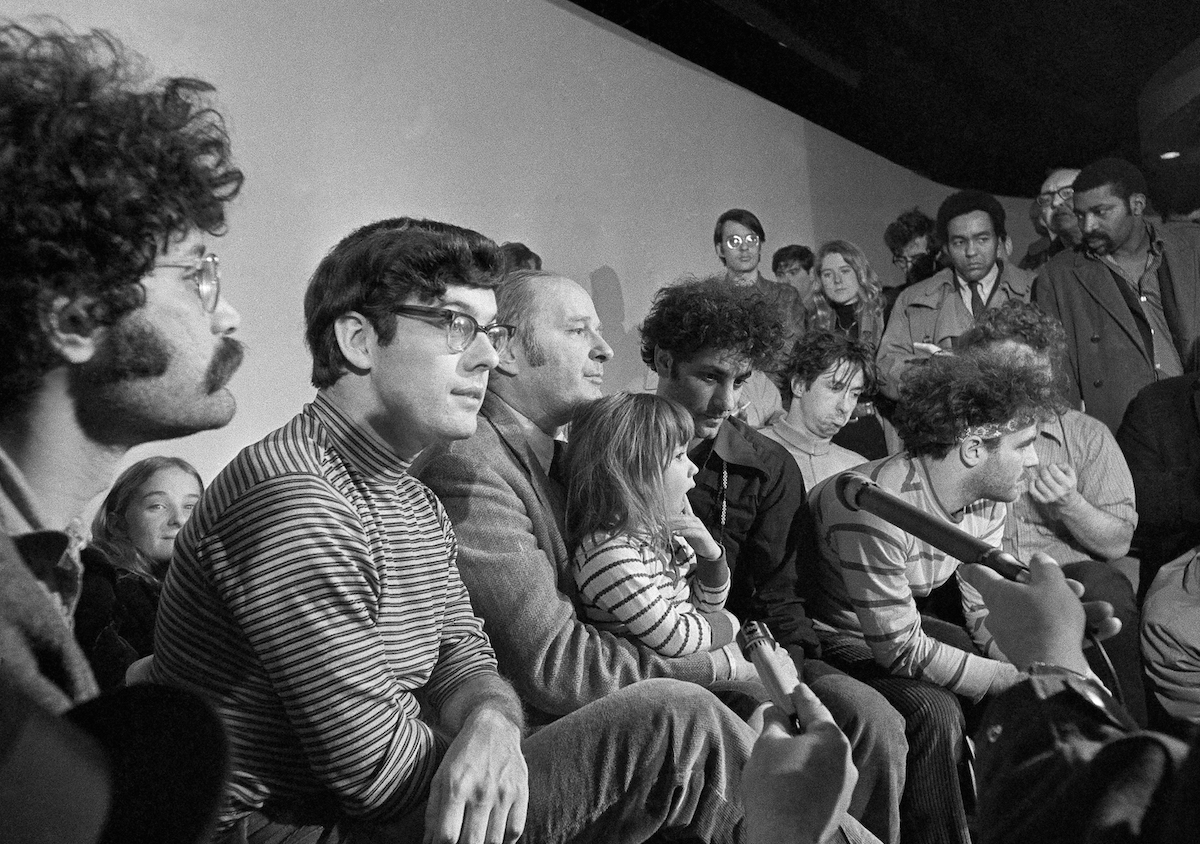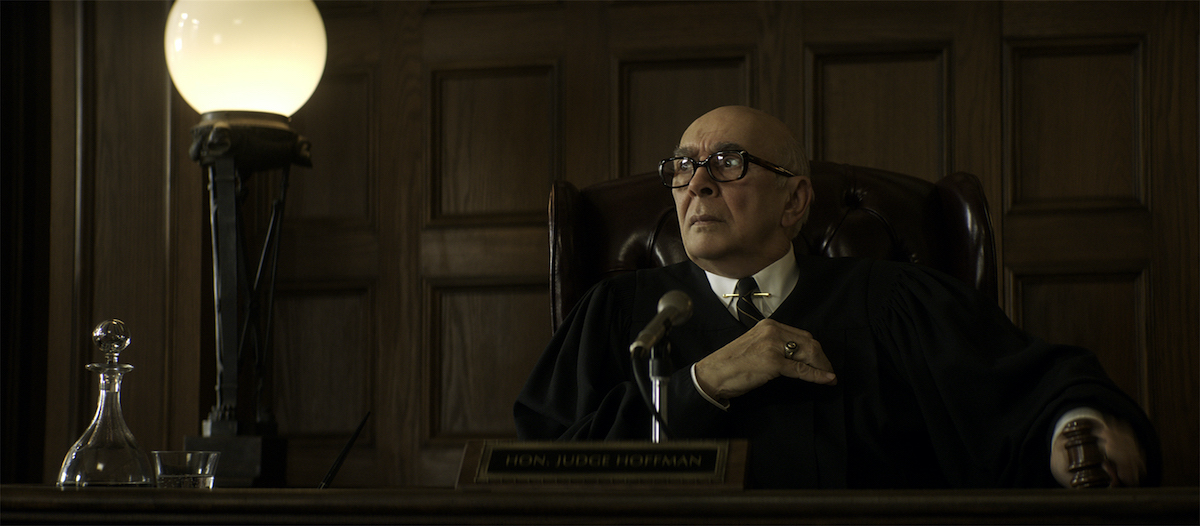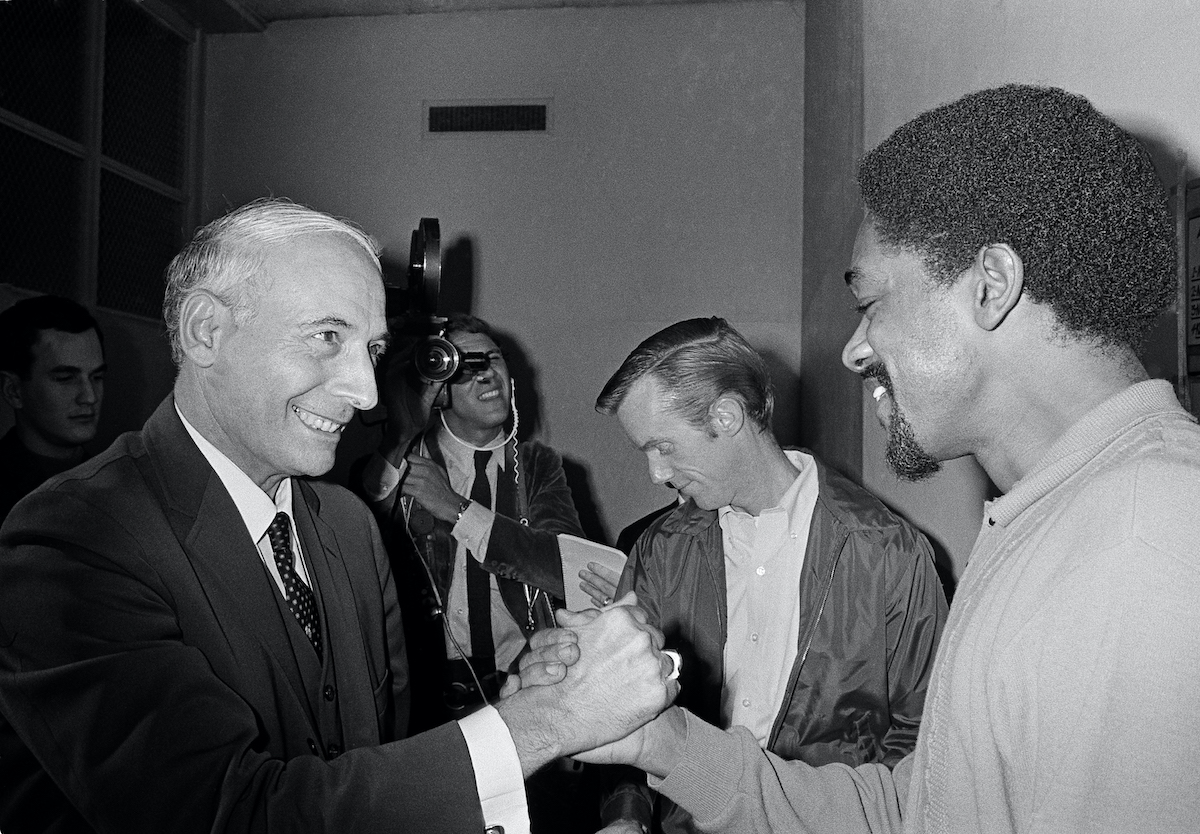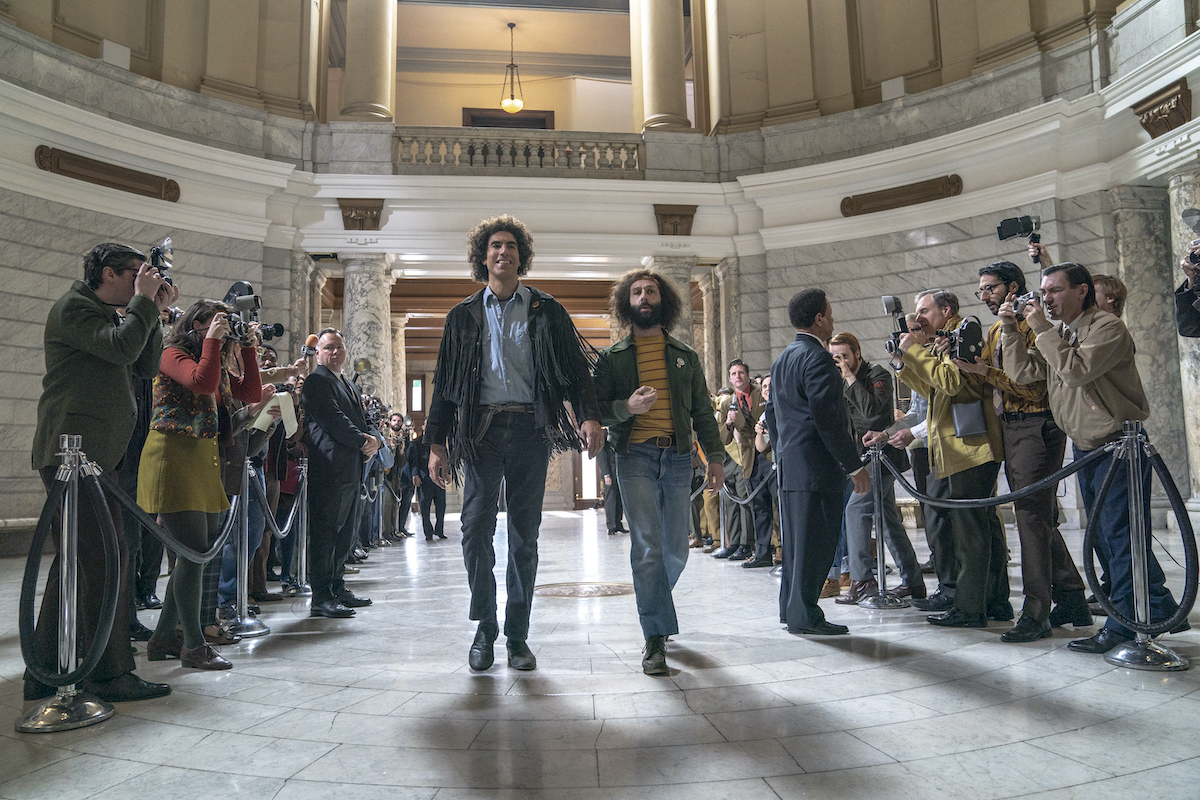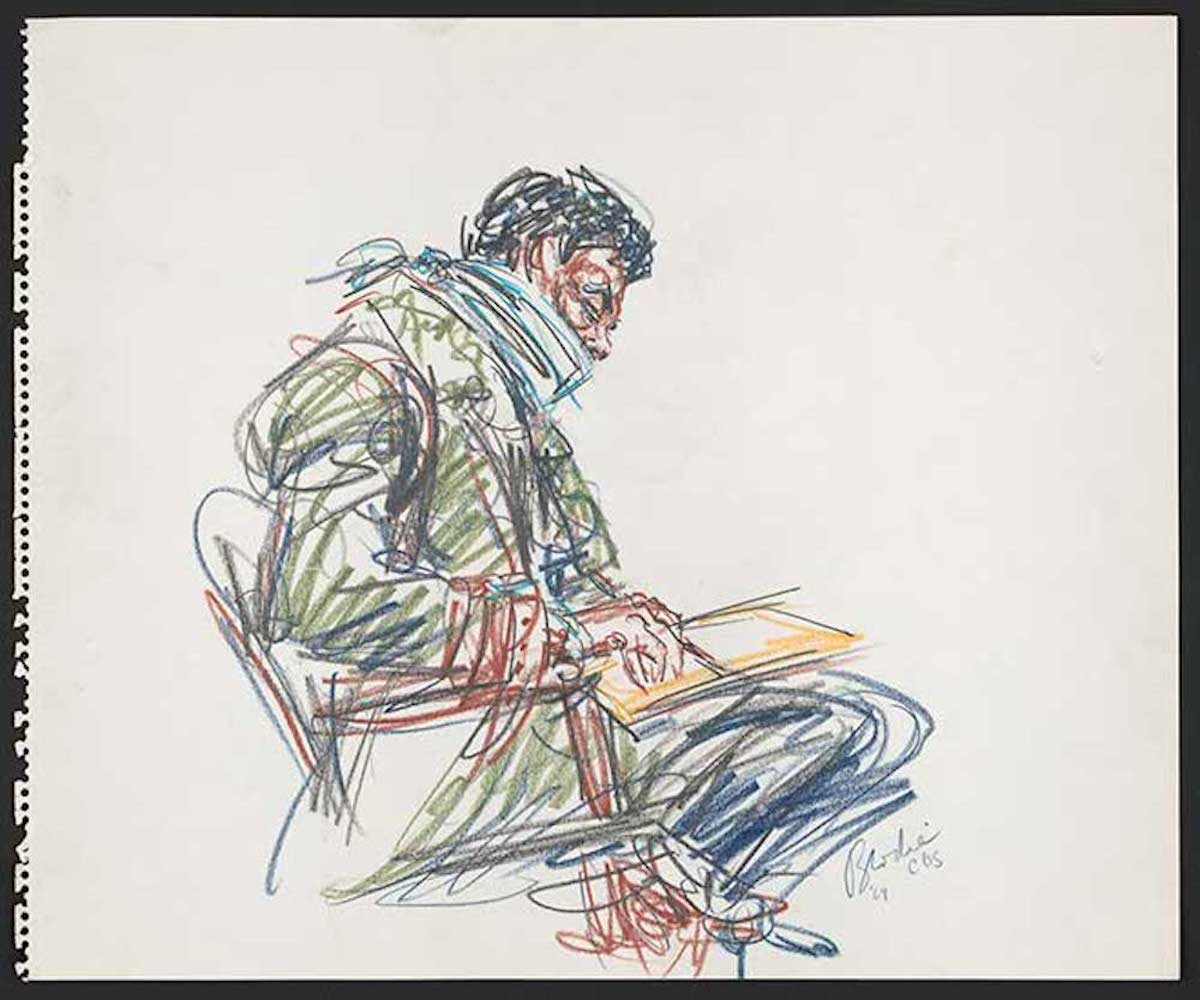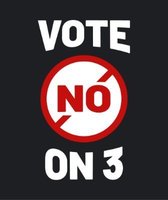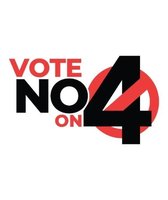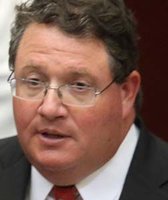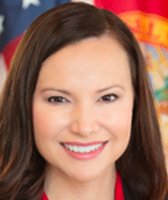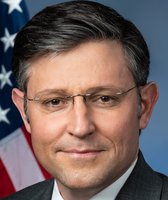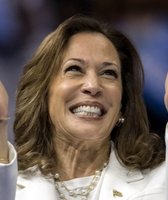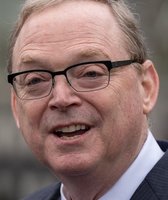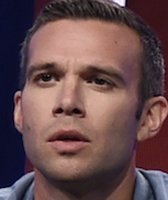Get PolitiFact in your inbox.
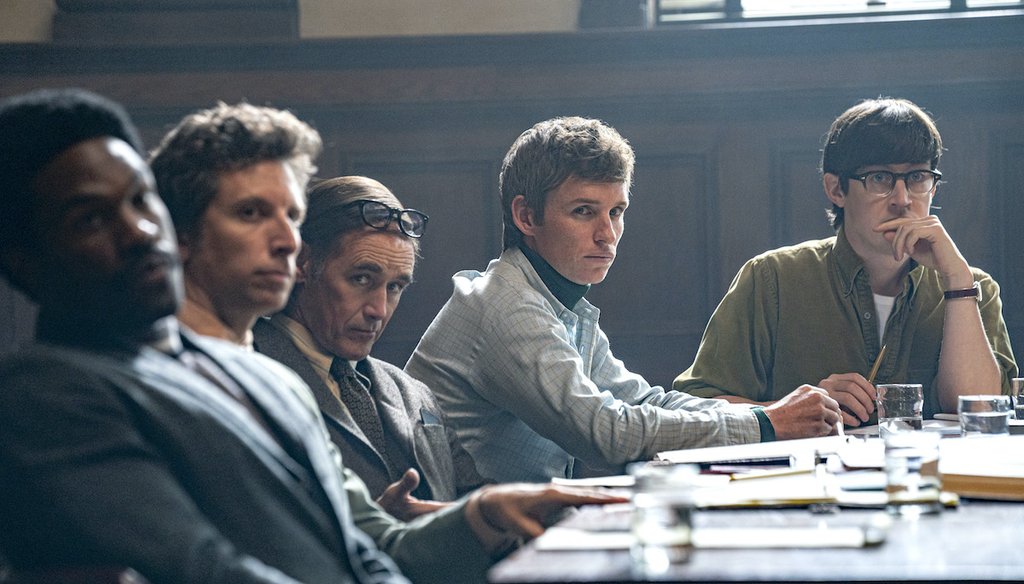
The Trial of the Chicago 7. From left, Yahya Abdul-Mateen II as Bobby Seale, Ben Shenkman as Leonard Weinglass, Mark Rylance as William Kuntsler, Eddie Redmayne as Tom Hayden, Alex Sharp as Rennie Davis. (Netflix)
Editor's note: Have you ever wondered if the movie you just saw — that claimed to be based on a real story or historical events — was really accurate? So have we. With this year’s Oscars featuring historically based movies up for Best Picture honors, we wanted to help you sort out the facts from the dramatic liberties. (We've also fact-checked Judas and the Black Messiah and Mank.) Warning, major spoilers and plot points ahead!
What happens when one of Hollywood’s most famous writer-directors undertakes retelling one of the most infamous trials in modern U.S. history?
In Aaron Sorkin’s "The Trial of the Chicago 7," which debuted on Netflix in October 2020, the answer is a mixture of accuracy and narrative embellishment. It tells the story of a group of activists who were on trial after they traveled to Chicago to protest U.S. involvement in the Vietnam War at the 1968 Democratic National Convention.
Four days of riots and violence broke out Aug. 25-28 as Chicago police, armed with tear gas and billy clubs, tried to enforce an 11 p.m. curfew in the city’s parks, where many of the protesters were camped.
Originally the Chicago Eight, the activists featured in the film faced federal charges of conspiracy and crossing state lines with the intent to start a riot. The defendants included Abbie Hoffman, Jerry Rubin, Tom Hayden, Rennie Davis, David Dellinger, John Froines, Lee Weiner and Bobby Seale, who was a co-founder of the Black Panther Party. Seale was eventually removed from the proceedings due to a mistrial, dropping the number of defendants to seven.
Sign up for PolitiFact texts
The trial drew widespread media attention and lasted nearly five months, from September 1969 to February 1970. On Feb. 18, 1970, all were acquitted of conspiracy charges, with Froines and Weiner being acquitted of all charges. Five — Davis, Dellinger, Hayden, Hoffman and Rubin — were fined $5,000 each and convicted of crossing state lines with the intent to riot, which carried a five-year prison sentence.
The seven defendants and their attorneys were also sentenced for the more than 170 contempt citations handed out by Judge Hoffman. Most of the contempt citations had a seperate appeal with many being thrown out, but not all.
The movie has received critical acclaim since its release, racking up five Oscar nominations, including ones for Best Picture and Best Original Screenplay.
But how does its portrayal measure up to history? Let’s look.
In reality: The defendants were known to disrupt and mock the judge throughout the trial. But the film’s portrayal of Hoffman being combative and biased is on the money.
Did Judge Hoffman, who was 74 at the time of the trial, actually treat the defendants and their lawyers as poorly as the film portrays?
Several accounts throughout history say he did. The judge, played by Frank Langella in the film, was known for enforcing strict courtroom decorum and had a reputation for being a bit of a crank. He was described in Joseph Goulden’s 1974 book about federal judges, "The Benchwarmers," as "impetuous and rude."
Multiple scenes in the film show the defendants disrupting proceedings, but the film actually understates their antics. For example, Seale was noted for calling the judge a "fascist dog," a "pig," and a "racist," among other things.
Still, even at the time of the trial, Judge Hoffman’s behavior was widely denounced, and the disdain he exhibited for the defense played a pivotal role in the sentencing appeal.
Douglas Linder is an author, historian and law professor at the University of Missouri-Kansas City, as well as the creator of "Famous Trials," a website that covers and chronicles over 50 famous trials throughout history.
Linder, who has written extensively about the Chicago 7 trial, told PolitiFact that the judge was quite close to Chicago Mayor Richard Daley, who was furious over the U.S. Justice Department’s initial lack of interest in prosecuting protest leaders.
"I was shocked by Judge Hoffman's treatment of the defense lawyers, Kunstler and Weinglass," said Charles Henry, professor emeritus of African American studies at the University of California, Berkeley, who attended the trial while in college. "On several occasions they rose to make objections and were either told to sit down or overruled before they had completed their first sentence. Of course they were threatened and then fined for contempt of court."
Judge Hoffman issued a total of 175 contempt of court citations during the trial, for everything from argumentation to laughing, blowing kisses and correcting him when he mispronounced names.
In the movie: Bobby Seale has no legal representation in court because his attorney was undergoing surgery. The judge denies Seale’s requests to delay the trial or to let him represent himself.
In reality: Seale’s lawyer, Charles Garry, had gallbladder surgery and was unable to represent him because the court wouldn’t grant a continuance.
During the pretrial, Seale was represented by a group of lawyers that included Charles Garry, a civil rights attorney who was chief counsel to the Black Panther Party. Seale believed that Garry alone would represent and fired his other lawyers.
That was before Garry unexpectedly needed gallbladder surgery and moved for the trial to be postponed six months, a motion that Judge Hoffman denied.
According to Tucker Carrington’s "The Role of Judging 50 Years After the ‘Chicago Seven’ Trial: A Remembrance of Charles R. Garry," Garry promised the court that he would try the case immediately after his operation and recovery. By Garry’s account, Judge Hoffman turned the request down cold, despite having granted several other continuances that morning.
That left Seale without counsel, which he disruptively noted throughout the proceedings.
One thing the film gets wrong is that it exaggerates Fred Hampton’s role in the trial. In the movie, Hampton, the chairman of the Illinois chapter of the Black Panther Party, is seen in the courtroom speaking to Seale, giving him advice while Seale is seated at the defense table. But, while some Black Panthers were likely at the trial — including Hampton— there is no evidence that Hampton provided advice to Seale in the open courtroom. Rather, the marshals prevented the two from talking to each other.
In Hayden’s memoir "Reunion," he says that Hampton did work on Seale’s behalf, but in a way that was not so visible during courtroom proceedings. Hampton "brought messages to Bobby faithfully every morning in court and made calls in his behalf during the day," Hayden wrote. "In addition, a black law student named Mickie Leaner kept the Panther lawyer supplied with legal citations ... which Bobby carefully wrote into his yellow pads."
In the movie: A female undercover FBI agent seduces Jerry Rubin and shows sympathy for him during the trial.
In reality: Agent Daphne O'Connor is a fictional character, but there were multiple undercover intelligence agents who infiltrated the activists.
In the film, FBI agent Daphne O'Connor played by actress Caitlin Fitzgerald, is shown seducing Rubin, portrayed by Jeremy Strong, and later in the trial appears to show sympathy for him. But the character was entirely Sorkin’s creation. Rubin was married to Nancy Kurshan at the time.
There were three undercover agents — all male — who infiltrated the protesters and testified during the trial. FBI director J. Edgar Hoover only allowed men to be special agents — a rule that changed only after his death in 1972. The closest equivalent to O'Connor was Robert Pierson, an investigator for the Cook County State's Attorney’s Office, who became Rubin’s bodyguard. In his testimony, Pierson said he grew his hair and beard out and dressed up as a biker to blend in with a motorcycle gang.
Thanks to his undercover work, Pierson was able to overhear and later repeat many of the conversations among the Yippies, the activist group that Rubin and Abbie Hoffman led.
"Basically, the prosecution’s case was made through these undercover agents coupled with the activists’ public speeches," Linder told PolitiFact. "These agents tried to link things and suggested tactical moves and the specific things they (the Yippies) did that were not public knowledge."
In the movie: Tom Hayden tells the crowd, "If blood is gonna flow, let it flow all over the city," but intended to say "our blood," meaning only the protesters'.
In reality: There’s no indication Hayden was referring only to the blood of protesters, and not police.
Experts and witnesses say that Hayden, portrayed by Eddie Redmayne, did not accidentally forget to use the pronoun "our'' in the speech, as the film implies.
The speech in question took place in the late afternoon of Aug. 28, 1968, at the peak of the week’s violence. Dellinger, Seale, Davis and Hayden addressed 10,000 to 15,000 demonstrators at the bandshell in Grant Park, opposite the Democratic Convention headquarters hotel.
But Hayden didn’t want a march to the convention, according to Dean Blobaum, the owner of Chicago68.com, a website devoted to examining myths and facts about the events during the 1968 convention.
As the rally came to an end, Hayden and Dellinger did have a disagreement (as the movie shows) but it was about tactics. Dellinger wanted the crowd to march to the International Amphitheatre while Hayden wanted people to break into small groups and disperse around the Loop.
They presented the crowd with alternatives, with Dellinger speaking first and laying out instructions to assemble for the march. Hayden spoke next and ended with: "If blood is going to flow, let it flow all over the city. If gas is going to be used, let it come down all over Chicago. If police are going to run wild, let them run wild all over the city.… Don’t get trapped in some kind of large, organized march which can be surrounded. Begin to find your way out of here. I’ll see you in the streets."
Hayden's entire speech was entered into evidence by the prosecution, but we could find no instance in the edited transcripts that Abbie Hoffman was asked any questions about Hayden's words at the bandshell, as the movie shows.
In the movie: Jerry Rubin and Abbie Hoffman show up in judges robes. The judge orders them to take the costumes off, at which point the pair throw the garments to the floor to reveal that they are wearing police uniforms underneath.
In reality: Rubin and Hoffman did show up toward the end of the trial in judges robes, but some reports say it was only Hoffman wearing a police uniform.
Rubin and Abbie Hoffman did show up to court one day in judges robes, but this happened toward the end of the trial, on Feb. 6, 1970, a few days before closing arguments. But there are contradictory reports about whether both men were wearing police uniforms underneath the robes. Some reports say only Hoffman, who is played by Sacha Baron Cohen in the movie, donned both costumes.
It wasn’t the only stunt the defendants pulled. They also brought a birthday cake into the courtroom, bared their chests and placed the flag of the National Liberation Front on the defense table.
In the movie: Judge Hoffman orders Bobby Seale to be bound and gagged over his disruptions. Richard Schultz, a junior prosecutor on the case played by actor Joseph Gordon-Levitt, decries the action and pushes for the judge to declare a mistrial, which he eventually does.
In reality: Seale was bound and gagged for multiple days before his case was declared a mistrial. There’s no evidence that the prosecution pushed for the mistrial.
In the film, Seale, portrayed by Yahya Abdul-Mateen II, repeatedly interrupts the proceedings, noting that he has no attorney present. Due to his disruptions — at one point, Seale stands and decries the slaying of Hampton the previous night — Judge Hoffman orders that Seale be taken away. In Seale’s absence, the courtroom is still as the horrific sounds of Seale being beaten off-camera overtake the room. Seale soon returns, bound and gagged.
Seale was indeed seated on trial in an American courtroom, bound and gagged — but the scene was, by some measures, more brutal than the one-time incident depicted in the film. In reality, he was gagged, tied up and chained to his chair at the defense table for at least three days. And a full week elapsed between the first time Seale was forcibly restrained and when the judge declared a mistrial.
Blobaum says there isn’t a clear record that those in the courtroom could hear marshals struggling with Seale in another room as is depicted in the movie. But he said there was one day, Oct. 30, when those present in the courtroom watched the marshals struggle with Seale, Rubin and Hoffman as Seale’s arm came unbound, his chair tipped over and he cried out, saying he was being hit in the scrotum.
"Seale talks a lot about those three days in his memoir ‘Seize the Time,’" Blobaum said. "He put up a lot of resistance to being gagged, and he was physically restrained by the marshals. Other than what happened in the courtroom on the 30th, he doesn't talk in terms of being punched or abused by them, beyond the abuse of binding and gagging."
Judge Hoffman’s treatment of Seale drew wide condemnation. After a week, the judge allowed Seale’s restraints to be removed on the condition that the defendant stop disrupting. Seale continued to interrupt, and the judge declared a mistrial in his case. It wasn’t because the prosecution or defense attorneys requested it in open court, as the movie portrays. Kunstler made a motion on Nov. 3 for a mistrial of all defendants, which was denied. Seale’s case was severed on Nov. 5.
Sorkin’s screenplay also rearranged time. In real life, Seale was chained to his chair on Oct. 29, 1969. But Hampton wasn’t killed until Dec. 4.
In the movie: Hayden reads the names of fallen Vietnam soldiers in court at the close of the trial.
In reality: Defendant David Dellinger, not Hayden, attempted to read the names of the war dead earlier in the trial before the judge shut him down.
The film’s climactic finale, which shows Hayden reading the names of the Americans who died in the Vietnam War during the trial, never happened.
A reading of some of the war dead took place earlier in the trial on Oct. 15, 1969, when Vietnam Moratorium Day, a massive, national anti-war demonstration and teach-in, was being observed by millions of Americans.
It was also read by Dellinger, not Hayden. Dellinger read names of both U.S. and Vietnamese casualties but didn’t get far before the judge cut it off.
Our Sources
Netflix, The Trial of the Chicago 7, released Oct. 16, 2020
HistoryvHollywood.com, THE TRIAL OF THE CHICAGO 7 (2020), Accessed April 6, 202
Famous Trials, The Chicago Eight Conspiracy Trial: An Account by Professor Douglas Linder, Accessed April 10, 2021
Chicago68.com, Fact-checking Sorkin, Accessed April 11, 2021
The New York Times, Court Voids 5 Convictions In 1968 Convention Case, Nov. 22, 1972
The New York Times, KUNSTLER GIVEN FOUR‐YEAR TERM BY CHICAGO JUDGE, Feb. 16, 1970
Loyola University Chicago School of Law, The Role of Judging 50 Years After the "Chicago Seven" Trial: A Remembrance of Charles R. Garry by Tucker Carrington, 2019
The Harvard Crimson, 13 at Law School Protest Judge's Action in Chicago, Oct. 1, 1969
Famous Trials, Testimony of Robert Pierson, Oct. 8, 1969
Amazon, Conspiracy in the Streets: The Extraordinary Trial of the Chicago Seven by Jon Wiener, Aug. 7, 2006
Amazon, The Trial of the Chicago 7: The Official Transcript Paperback by Mark L Levine, Oct. 6, 2020
United States Court of Appeals for the Seventh Circuit, United States of America V. Seale, 1970
Time, The Trial of the Chicago 7 Is a Riveting Movie. But the True Story Is Even More Dramatic, Oct. 16, 2020
The Chicago Tribune, The only Chicagoan of the Chicago 7 just wrote a memoir and says he’s a fan of the Netflix movie ‘Trial of the Chicago 7’, Oct 15, 2020
The New York Times, The Chicago 7 Trial Onscreen: An Interpretation for Every Era, Oct. 18, 2020
The Guardian, The whole world is watching. How the 1968 Chicago 'police riot' shocked America and divided the nation, Aug. 19, 2018
PBS, What Became of the Chicago Seven?, Oct. 19, 2015
Smithsonian Magazine, The True Story of ‘The Trial of the Chicago 7’, Oct. 15, 2020
Slate, What’s Fact and What’s Fiction in The Trial of the Chicago 7, Oct. 15, 2020
Screenrant, The Trial of the Chicago 7 True Story: What The Movie Changes, Oct. 17, 2020
Email interview, Charles Henry, professor emeritus of African American studies at the University of California, Berkeley, April 8, 2021
Phone interview, Douglas Linder, author, historian and law professor at the University of Missouri-Kansas City, and creator of Famous-Trials.com, April 9, 2021
Phone/Email interview, Dean Blobaum owner of Chicago 68.com, April 12-13, 2021

